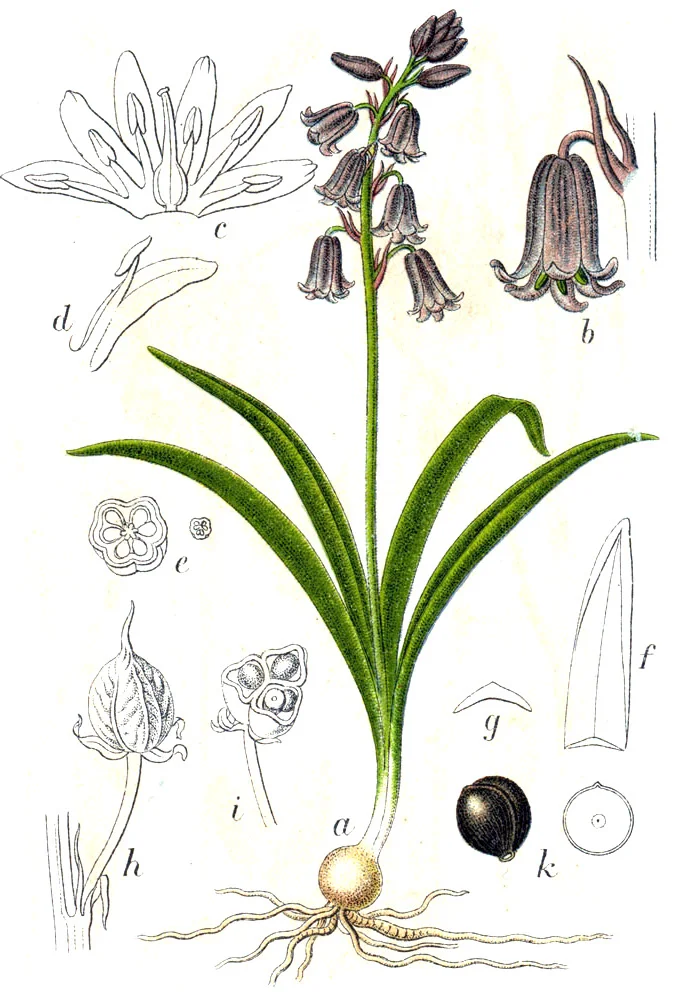Photo by Christophe Couckuyt licensed under CC BY 2.0
Whether in your garden or in the woods, common bluebells (Hyacinthoides non-scripta) are a delightful respite from the dreary months of winter. It should come as no surprise that these spring geophytes are a staple in temperate gardens the world over. And, as amazing as they are in the garden, bluebells are downright fascinating in the wild.
Bluebells can be found growing naturally from the northwestern corner of Spain north into the British Isles. They are largely a woodland species, though finding them in meadows isn't uncommon. They are especially common in sites that have not experienced much soil disturbance. In fact, large bluebell populations are used as indicators of ancient wood lots.
Photo by RX-Guru licensed under CC BY-SA 3.0
Being geophytes, bluebells cram growth and reproduction into a few short weeks in spring. We tend to think of plants like this as denizens of shade, however, most geophytes get going long before the canopy trees have leafed out. As such, these plants are more accurately sun bathers. On warm days, various bees can be seen visiting the pendulous flowers, with the champion pollinator being the humble bumble bees.
The above ground beauty of bluebells tends to distract us from learning much about their ecology. That hasn't stopped determined scientists though. Plenty of work has been done looking at how bluebells make their living and get on with their botanical neighbors. In fact, research is turning up some incredible data regarding bluebells and mycorrhizal fungi.
Photo by Mick Garratt licensed under CC BY-SA 2.0
Bluebell seeds tend not to travel very far, most often germinating near the base of the parent. Germination occurs in the fall when temperatures begin to drop and the rains pick up. Interestingly, bluebell seeds actually germinate within the leaf litter and begin putting down their initial root before the first frosts. Often this root is contractile, pulling the tiny seedling down into the soil where it is less likely to freeze. During their first year, phosphorus levels are high. Not only does the nutrient-rich endosperm supply the seedling with much of its initial needs, abundant phosphorus near the soil surface supplies more than enough for young plants. This changes as the plants age and change their position within the soil.
Photo by MichaelMaggs licensed under CC BY-SA 3.0
Over the next 4 to 5 years, the bluebell's contractile roots pull it deeper down into the soil, taking it out of the reach of predators and frost. This also takes them farther away from the nutrient-rich surface layers. What's more, the roots of older bluebells are rather simple structures. They do not branch much, if at all, and they certainly do not have enough surface area for proper nutrient uptake. This is where mycorrhizae come in.
Bluebells partner with a group of fungi called arbuscular mycorrhiza, which penetrate the root cells, thus greatly expanding the effective rooting zone of the plant. Plants pay these fungi in carbohydrates produced during photosynthesis and in return, the fungi provide the plants with access to far more nutrients than they would be able to get without them. One of the main nutrients plants gain from these symbiotic fungi is phosphorus.
Photo by Oast House Archive licensed under CC BY-SA 2.0
For bluebells, with age comes new habitat, and with new habitat comes an increased need for nutrients. This is why bluebells become more dependent on arbuscular mycorrhiza as they age. In fact, plants grown without these fungi do not come close to breaking even on the nutrients needed for growth and maintenance and thus live a shortened life of diminishing returns. This is an opposite pattern from what we tend to expect out of mycorrhizal-dependent plants. Normally its the seedlings that cannot live without mycorrhizal symbionts. It just goes to show you that even familiar species like the bluebell can offer us novel insights into the myriad ways in which plants eke out a living.
Photo Credits: [1] [2] [3] [4] [5]








